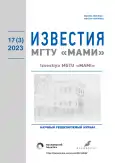Algorithm for forming traction and braking torque settings at the shaft of a traction motor by means of a single pedal
- Authors: Klimov A.V.1,2
-
Affiliations:
- KAMAZ Innovation Center LLC, Skolkovo Innovation Center
- Moscow Polytechnic University
- Issue: Vol 17, No 3 (2023)
- Pages: 261-271
- Section: Transport and transport-technological facilities
- URL: https://journals.rcsi.science/2074-0530/article/view/249927
- DOI: https://doi.org/10.17816/2074-0530-321668
- ID: 249927
Cite item
Full Text
Abstract
BACKGROUND: Transport service providers and consumers specify requirements to vehicles for increasing energy efficiency, cost reduction, as well as improving ergonomics and comfort. Fuel costs are among the significant costs, so it is very promising to use vehicles with electric drives, such as battery-powered electric vehicles. It is very important for them to have energy-efficient control of traction drives that are the main sources of energy loss, characterized by high efficiency that helps to increase single-charge mileage. To achieve this, it is necessary to form the settings of the requested engine torque using the accelerator pedal only, taking into account traffic conditions, vehicle characteristics over the entire velocity range.
AIMS: Development of the fundamentals and the law of determining the settings of the traction and regenerative torque of a traction electric drive, the run-out mode depending on motion velocity and the accelerator pedal position, taking into account the required level of comfort and ergonomics of control.
METHODS: The law of determining the setting of the traction and regenerative torque of the traction electric drive, the run-out mode were modeled in the MATLAB/Simulink software package.
RESULTS: The fundamentals of building the law of determining of the setting of the traction and regenerative torque of the traction electric drive, the run-out mode for effective control, increasing ergonomics and comfort of a vehicle, as well as the results of virtual simulation of the formation of settings in the MATLAB/Simulink in conditions close to the operational are given in the paper.
CONCLUSIONS: The practical value of the study lies in the possibility of using the proposed law for determining the setting of the traction and regenerative torque of the traction electric drive, the run-out mode for the development of a traction drive control system for transport vehicles.
Full Text
##article.viewOnOriginalSite##About the authors
Alexander V. Klimov
KAMAZ Innovation Center LLC, Skolkovo Innovation Center; Moscow Polytechnic University
Author for correspondence.
Email: klimmanen@mail.ru
ORCID iD: 0000-0002-5351-3622
SPIN-code: 7637-3104
Scopus Author ID: 57218166154
Cand. Sci. (Tech.), Associate Professor of the Advanced Engineering School of Electric Transport, Head of the Electric Vehicles Department
Russian Federation, Moscow; MoscowReferences
- Characteristics of the KAMAZ 6282 electric bus. Naberezhnye Chelny: Kamaz. Accessed: 15.10.2022. Available from: https://kamaz.ru/upload/bus/%D0%AD%D0%BB%D0%B5%D0%BA%D1%82%D1%80%D0%BE%D0%B1%D1%83%D1%81%20KAMAZ-6282.pdf
- Zhileykin MM, Klimov AV, Maslennikov IK. Control signal algorithm of the accelerator pedal providing an effective energy consumption by an electrobus traction gear. Izvestiya MGTU MAMI. 2022;16(1):51-60. doi: 10.17816/2074-0530-100232
- Biryukov VV, Porsev EG. Traction electric drive: textbook. allowance. 2nd ed. NovoSibirsk: Izd-vo NGTU; 2018.
- Kulas RA, Rieland H, Pechauer J. A System Safety Perspective into Chevy Bolt’s One Pedal Driving. SAE Technical Paper. 2019;01(0133). doi: 10.4271/2019-01-0133
- Wang J, Besselink IJM, van Boekel JJP, et al. Evaluating the energy efficiency of a one pedal driving algorithm. 1–10. In: 2015 European Battery, Hybrid and Fuel Cell Electric Vehicle Congress (EEVC 2015), Brussels, Belgium. Brussels; 2015.
- Zhileikin MM, Kotiev GO. Modeling of vehicle systems: textbook. Moscow: MGTU im NE Baumana; 2020.
Supplementary files























